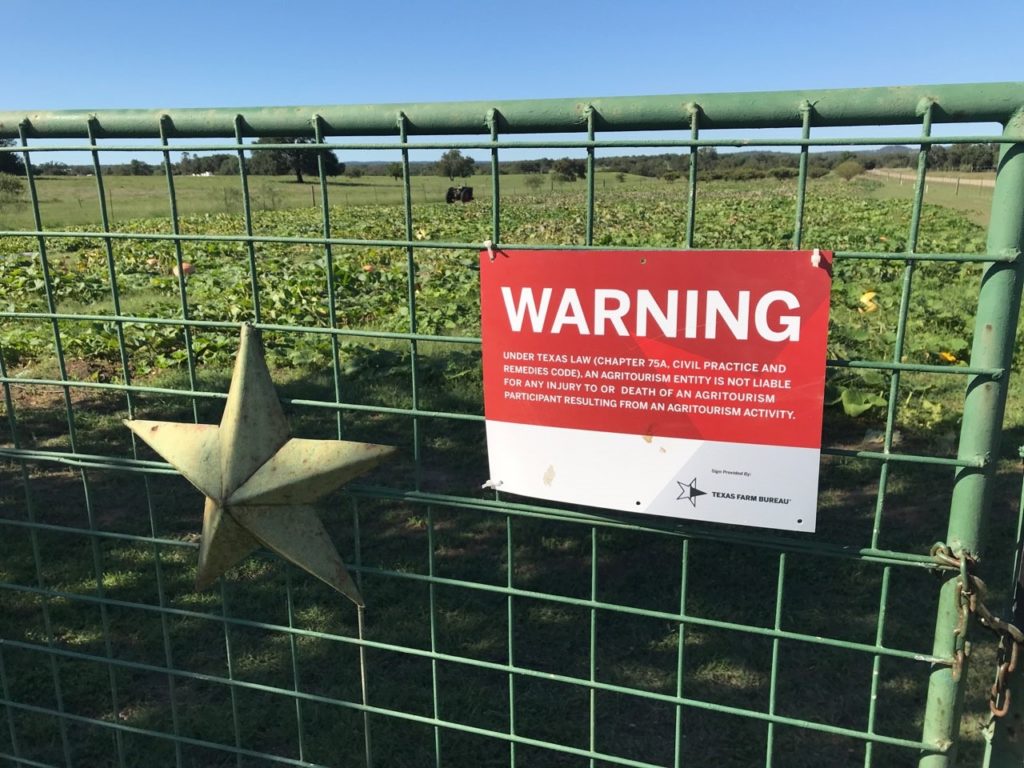by Tiffany Lashmet, Texas A&M AgriLife Extension Services
After my blog post about amendments to the Texas Farm Animal Liability Act, my email inbox was bombarded with questions about the various signs that landowners should consider having, what the differences are between the signs, and where to purchase the signs. I thought it might be helpful to do a rundown on the common signs landowners should consider having from a liability protection perspective.

Rural landowners should consider hanging two signs from a liability protection perspective: The Texas Farm Animal Liability Act sign and the Texas Agritourism Act sign. Additionally, although not liability-related, rural landowners often have questions related to hanging “No Trespassing” signage, so I will address that as well.
Texas Farm Animal Liability Act Signage
The Texas Farm Animal Liability Act protects farm animal owners from liability if a participant in a farm animal activity is injured due to a risk inherent to a farm animal activity. The classic example is that there is always an inherent risk that someone who gets on a horse could get bucked off. This statute aims to shield the horse owner from liability in that situation. For a much more in depth discussion about the Farm Animal Liability Act and recent changes made by the Texas Legislature, click here.
As of September 1, 2021, the Farm Animal Liability Act will require Texas farms and ranches, farm animal professionals, and farm or ranch lessees to hang a Farm Animal Liability Act sign pursuant to the statute.
The required sign language is:
WARNING
UNDER TEXAS LAW (CHAPTER 87, CIVIL PRACTICE AND REMEDIES CODE), A
FARM ANIMAL PROFESSIONAL OR FARM OWNER OR LESSEE IS NOT LIABLE FOR
AN INJURY TO OR THE DEATH OF A PARTICIPANT IN FARM ANIMAL
ACTIVITIES, INCLUDING AN EMPLOYEE OR INDEPENDENT CONTRACTOR,
RESULTING FROM THE INHERENT RISKS OF FARM ANIMAL ACTIVITIES.
This sign must be posted at a clearly visible location.
Landowners or lessees can certainly make their own signs, or various groups sell these signs. This includes the Texas & Southwestern Cattle Raisers Association and Texas Farm Bureau. Because the required language will change as of September 1, I recommend ensuring you obtain a sign with the most recent statutory language.
Texas Agritourism Act Signage
The Texas Agritourism Act, passed in 2015, provides limited liability for rural landowners of “agricultural land” if someone is injured on the land while engaged in a recreational or educational activity. For the purposes of this statute, “agricultural land” is land that is suitable for growing crops or raising livestock. A recreational activity is broadly defined as including hunting, fishing, hiking, biking, swimming, pleasure driving, picnicking, nature photography, and “anything else associated with enjoying nature or the outdoors.” For example, if someone were injured while hunting or while participating in a field day, this statute would be a potential defense for the rural landowner. To read more about the Texas Agritourism Act, click here.
In order to receive the Agritourism Act’s protections, a landowner must either hang a Texas Agritourism Act sign or obtain a signed Texas Agritourism Act release signed by the injured participant.
The required language to be included on the signs is as follows:
WARNING: UNDER TEXAS LAW (CHAPTER 75A, CIVIL PRACTICE AND REMEDIES CODE), AN AGRITOURISM ENTITY IS NOT LIABLE FOR ANY INJURY TO OR DEATH OF AN AGRITOURISM PARTICIPANT RESULTING FROM AN AGRITOURISM ACTIVITY.
The sign must be clearly visible on or near the premises where the activity is conducted.
A number of groups sells these signs, and I’ve compiled a list and relevant links here.
No Trespassing Signage
Again, although no trespassing signs are not related to landowner liability protection, these signs generate a number of questions from landowners.
Keep in mind that there are two types of trespassing claims: Civil and criminal. The presence of a no trespassing sign is irrelevant in the civil trespass context. The signs are important, however, in a criminal trespass claim. To read more about each of these types of trespass claims, click here and go to Chapter 7.
Texas Penal Code Section 30.05 provides that for a person to be found guilty of criminal trespass, he must have entered the property of another without permission and with knowledge that such entry was prohibited. A landowner, lessee, or occupier can provide this notice that entry is forbidden in a number of ways under the statute including no trespassing signs, purple paint, verbal or written warnings, by having crops under harvest or cultivation, or by having the area completely fenced in obviously designed to keep animals in or people out.
So, while landowners must take some action to inform someone that entry is not allowed, they may do so by hanging a no trespassing sign, or may select one of the other options. A landowner choosing to post the sign must do at a location reasonably likely to come to the attention of intruders. The sign’s language must simply indicate that entry is forbidden.
More Information on Landowner Liability
Landowner liability is probably my favorite topic, so if you want to learn more, I have a wealth of resources available to you!
To read a chapter discussing this topic, including 5 key steps for rural landowners to take to protect against potential liability, click here (and go to Chapter 5).
To listen to a prior podcast episode I did with Trace Blair talking about landowner liability statutes, click here. (Note that this was recorded in 2018 and does not include a discussion of the changes to the Texas Farm Animal Liability Act).
To hear me chat about liability insurance with Shayna Dorsey, click here.
Finally, landowner liability is one of the topics we cover in our Online Owning Your Piece of Texas course. You can check out the entire course here, or if you are only interested in the landowner liability topic, click here.





























